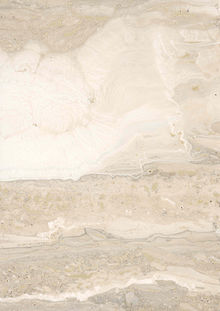Travertino Toscano
Travertino Toscano is a freshwater limestone that was formed in the Sienese sedimentary basin during the Holocene . This travertine is mined in the east of this basin near the Italian municipality of Rapolano Terme in Tuscany .
Names
In addition to the Travertino Toscano, there are other names like Pietre di Rapolano , Travertino Siena or Travertino Etrusco . In international trade, this natural stone is supplemented by Italian color names in addition to the name: Chiaro ( light ), Scuro ( dark ), Rosato ( reddish ), Nocciola ( nut brown ), Giallo ( yellow ) and Argentato ( silver ).
Geology and formation
In the large sedimentation area around Siena there are numerous hydrothermal springs that are fed by waters that penetrate through subterranean crevices to the surface of the earth. These waters, which are still discharged to this day, dissolved limestone and became saturated with calcium carbonate . After exiting on mountain slopes, the heated water flowed to the valley and filled depressions. The water cooled down, the calcium carbonate was precipitated and deposited. In this process, rock complexes with a thickness of up to 50 meters were created. Since the thermal springs dried up at times, the gradually created layers of clay and fine sand were superimposed and thereby separated from each other.
Rock description and mineral inventory
Due to the large extent of the deposit of this travertine, it is available in different colors. The different colors of this rock cause varying levels of iron minerals. The colors vary depending on the rock layer. They range from light to dark, reddish, nut brown, yellow and silver gray. The color of the rock causes different levels of iron oxides .
All types of rock in Tuscan travertine show pronounced bands when they are sawn against the bearing and used as natural stone. If this travertine is sawn open with the bearing, the banding is no longer recognizable on the visible surface. The stone surface is then denser and shows clouds and streaks.
use

This rock was already used for building by the Etruscans and Romans . In the area around Siena, travertine is a building block that is frequently used to this day. The light travertine type has gained importance in the architecture of Europe. This travertine has been used in Germany for more than 100 years.
Since Tuscan travertine has a low effective porosity, it is frost-resistant. If it is installed as a floor covering outdoors, de-icing salt should not be applied in winter, because travertines are not resistant to chemical aggressors. Even polishing outdoors is not permanent because of the acid rain . Travertine Toscano can be polished.
Travertino Toscano is widely used in stone carving.
In construction, this travertine is now either filled or built with open pores.
See also
Web links
Individual evidence
- ↑ a b Andrea Brogi, Enrico Capezzuoli (2008): Travertine deposition and faulting: the fault-related travertine fissure-ridge at Terme S. Giovanni, Rapolano Terme (Italy) (in English), accessed on September 15, 2014
- ↑ Karlfried Fuchs: Natural stones from all over the world, discover, determine, use . Sheet 234. Vol. 2. Munich Callwey, Munich 1997, ISBN 3-7667-1267-5
- ↑ a b Friedrich Müller: INSK compact. The international natural stone index for the current market . Sheet 74.4. Siena Scuro Venato. Ebner Verlag, Ulm 1977

